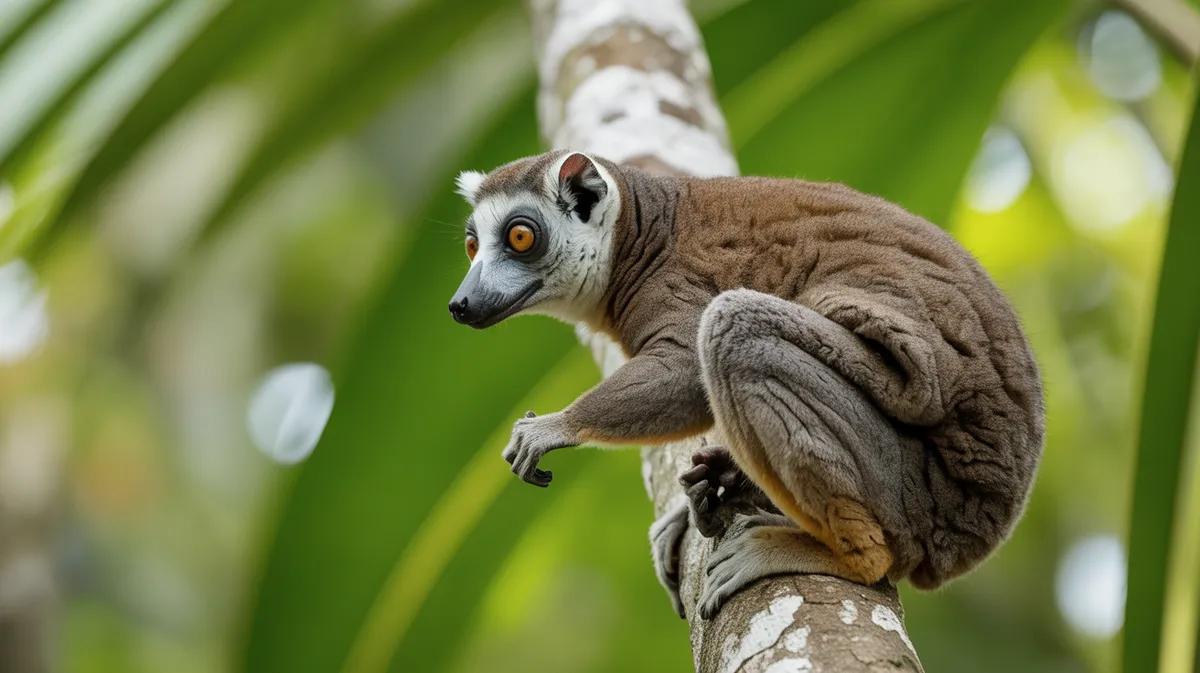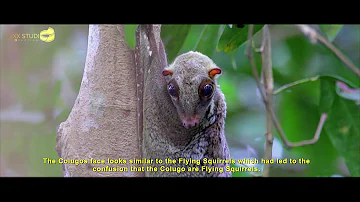
Sunda Flying Lemur
Galeopterus variegatus

Meet the Sunda Flying Lemur
The Sunda Flying Lemur, also known as the Malayan Colugo, is a gliding mammal native to Southeast Asia. Despite its name, it is neither a true lemur nor capable of powered flight; instead, it uses a large membrane stretching between its limbs and tail to glide gracefully between trees. Its soft, mottled fur provides excellent camouflage among the branches, and it is primarily nocturnal, spending daylight hours clinging motionless to tree trunks. The Sunda Flying Lemur feeds mainly on leaves, flowers, shoots, and fruits, and is highly adapted for an arboreal lifestyle.
Classification
Mammal
Habitat
Tropical rainforest
Diet
Herbivore
Lifespan
8-10 years
Conservation
Least Concern
Weight
0.9–1.3 kg
📖Fascinating Facts
Expert Gliders
Sunda Flying Lemurs can glide distances of up to 136 meters between trees without losing much altitude.
Strict Vegetarians
Their diet consists almost exclusively of leaves, flowers, young shoots, and fruit, which they harvest at night.
Unique Teeth
They possess comb-like lower incisors, which they use both for grooming and for scraping soft plant material from leaves.
📋Detailed Description
The Sunda flying lemur (Galeopterus variegatus), also known as the Malayan colugo, is a medium-sized, strictly arboreal mammal, measuring 33–42 cm in body length with a tail of 17–27 cm, and weighing between 0.9 and 1.3 kg. Its most distinctive feature is the patagium, an extensive gliding membrane that stretches from the neck, along the limbs, to the tips of the fingers, toes, and tail, forming the most complete gliding surface among mammals. This adaptation allows it to glide distances of over 100 meters between trees with minimal loss of altitude. The fur is dense, soft, and mottled gray, brown, or reddish, providing effective camouflage against tree bark and foliage. The head is small with large, forward-facing eyes adapted for nocturnal vision, and a blunt snout. Sunda flying lemurs are primarily nocturnal and spend the day clinging motionless to tree trunks, relying on their cryptic coloration for protection. Their limbs are long and slender, equipped with sharp, recurved claws for climbing. They possess a unique dental structure, including comb-like lower incisors, which may aid in grooming and feeding. This species is solitary, with individuals maintaining overlapping home ranges, and exhibits a slow, deliberate mode of locomotion when moving through the canopy. Their diet consists mainly of young leaves, shoots, flowers, fruits, and occasionally sap, making them important folivores and seed dispersers in their ecosystems.
💡 Did you know?
Despite their name, Sunda Flying Lemurs are not lemurs nor do they truly fly; they belong to their own unique order, Dermoptera.
🔬Research & Sources
Wikipedia Summary
The Sunda flying lemur, also called Malayan flying lemur and Malayan colugo, is the sole colugo species of the genus Galeopterus. It is native to Southeast Asia from southern Myanmar, Thailand, southern Vietnam, Malaysia to Singapore and Indonesia and listed as Least Concern on the IUCN Red List. Although it is called "flying lemur", it cannot fly but glides among trees and is strictly arboreal. It is active at night, and feeds on soft plant parts such as young leaves, shoots, flowers, and fruits. It is a forest-dependent species.
Last Modified: 5/24/2025
🎭Behavior & Social Structure
Sunda flying lemurs are strictly nocturnal and arboreal, rarely descending to the ground. At dusk, they become active, moving slowly and cautiously through the canopy in search of food. They are highly specialized gliders, launching themselves from tree trunks and using their patagium to control direction and speed during flight. Glides can reach distances of 100–136 meters, with minimal height loss, and are used both for foraging and escaping predators. Feeding is typically solitary, with individuals using their sharp claws to grasp branches and their specialized teeth to strip leaves and flowers. Vocalizations are infrequent but may include soft clicks or squeaks, especially during mother-infant interactions. Scent marking is believed to play a role in territory maintenance. Social interactions are limited outside of the mother-offspring bond, and direct encounters between adults are rare and may involve avoidance behaviors. During the day, they rest pressed flat against tree trunks, blending into the bark to avoid detection by predators such as large snakes, raptors, and civets.
👶Reproduction & Life Cycle
Reproduction in the Sunda flying lemur is characterized by a low reproductive rate. Breeding can occur year-round, but some populations may show peaks correlated with food availability. After mating, females undergo a gestation period of approximately 60 days. Typically, a single offspring is born, weighing around 35 grams at birth. The young are altricial, born with closed eyes and underdeveloped fur, and are carried by the mother clinging to her abdomen, protected and supported by the patagium, which functions similarly to a marsupial pouch. The mother nurses the infant for about 2–3 months, after which the young begin to explore independently but may remain with the mother for up to six months. Parental care is provided solely by the female, and there is no evidence of paternal involvement. Sexual maturity is reached at approximately 2–3 years of age.
🛡️Adaptations & Survival
The Sunda flying lemur exhibits a suite of remarkable adaptations for an arboreal and gliding lifestyle. The patagium is the most extensive among gliding mammals, allowing for efficient, controlled gliding and minimizing energy expenditure during locomotion. Their lightweight skeleton and elongated limbs enhance gliding performance. Large, forward-facing eyes provide excellent night vision, crucial for nocturnal foraging and navigation. The unique dental comb formed by lower incisors is used for grooming and possibly for scraping soft plant tissues. Their sharp, curved claws facilitate climbing and gripping onto tree bark. Cryptic coloration and the ability to flatten their bodies against tree trunks provide effective camouflage from predators. Behavioral adaptations include strict nocturnality, solitary foraging, and the use of gliding to escape threats and traverse large gaps in the forest canopy.
🎨Cultural Significance
The Sunda flying lemur has a limited but notable presence in local folklore and traditional beliefs across its range. In some Southeast Asian cultures, it is associated with supernatural abilities due to its gliding prowess and nocturnal habits. Its cryptic nature has led to myths about its invisibility or magical powers. There are few documented traditional uses, but in some areas, it has been hunted for food or perceived medicinal value. Increasingly, it is recognized as an important component of forest ecosystems and a flagship species for forest conservation in regional environmental education programs.
🔬Recent Research & Discoveries
Recent research on the Sunda flying lemur has focused on its gliding mechanics, revealing that it is among the most efficient mammalian gliders, with minimal energy loss during long-distance glides. Genetic studies have clarified its taxonomic status, distinguishing it from the Philippine colugo (Cynocephalus volans) and revealing significant genetic diversity across its range, suggesting possible cryptic subspecies. Studies of its diet using stable isotope analysis have highlighted its role as a primary folivore and seed disperser. Ongoing research includes the impact of habitat fragmentation on movement patterns, home range size, and population genetics. Technological advances such as GPS tracking and drone-based canopy surveys are providing new insights into its ecology and conservation needs.
🎥Wildlife Videos

Is This Weird Animal Our Closest Relative?
Colugos are sometimes called flying lemurs – even though they don't fly and are not lemurs. But what they really are, is a 200 year ...
Bizarre Beasts

Flying Lemur!!!!!
Real Wild Adventure

The Colugo
This is a video of the colugo taken from the BBC's Planet Earth documentary series.
globalzoo

"Master of the Air: The Extraordinary Gliding Abilities of the Sunda Flying Lemur"
Welcome to Animal Wildlife, a captivating channel that delves into the fascinating lives of wild animals and domestic pets. Through ...
ANIMAL LIFE

Colugo or flying Lemur documentary
If you love the documentary film and need some of the footage, it can be PURCHASE here under blackbox Guild. JSP is a ...
五阿哥 WuAhGe Studio Production

Sunda Colugo + Also known as the flying lemur #manakin #martialeagle #junglebird #flyinghippo
Unexpected
🌍Habitat Information
The Sunda Flying Lemur typically inhabits Tropical rainforest environments. Sunda Flying Lemurs have adapted to their environments with specialized features and behaviors.
Primary Habitat:
Tropical rainforest
More detailed habitat information will be available soon.
🛡️Conservation Status
The Sunda Flying Lemur is currently classified as Least Concern. Conservation efforts are crucial for preserving this species for future generations.
Common Threats:
- 🏠Habitat loss and fragmentation
- 🌡️Climate change impacts
- 🎯Hunting and poaching
- 🏭Human-wildlife conflict
⚠️Threats & Conservation Challenges
Although currently listed as Least Concern by the IUCN, the Sunda flying lemur faces several threats. The primary challenge is habitat loss and fragmentation due to deforestation, agricultural expansion, and urban development throughout Southeast Asia. While the species shows some adaptability to secondary forests and plantations, it is highly dependent on continuous canopy cover for movement and survival. Hunting for bushmeat and the pet trade occurs locally but is not widespread. Road mortality and predation by domestic animals are additional localized threats. Population trends are stable in some regions but declining in areas of intense habitat disturbance. Conservation challenges include maintaining large tracts of connected forest and mitigating human-wildlife conflict in rapidly developing landscapes.
🔬Scientific Classification
Scientific Name
Galeopterus variegatus
Classification Hierarchy
🔍 About Taxonomic Classification
Taxonomic classification is a hierarchical system used by scientists to classify and organize living organisms based on shared characteristics and evolutionary relationships.
The system moves from broad categories (Kingdom) to increasingly specific ones, with each animal's scientific name typically consisting of its Genus and species.
📝Community Notes
Share your observations and insights about the Sunda Flying Lemur with our community of wildlife enthusiasts.
Join Our Community
Sign in to share your observations and connect with fellow wildlife enthusiasts.
Sign In to ContributeNo community notes yet
Be the first to share your observations about the Sunda Flying Lemur!
Explore Sunda Flying Lemur
Select a tab above to learn more about this amazing animal.
📸Photo Gallery
No photos available for this animal yet.
🌟Discover More Wildlife
Continue your journey of discovery with more fascinating animals from our database
